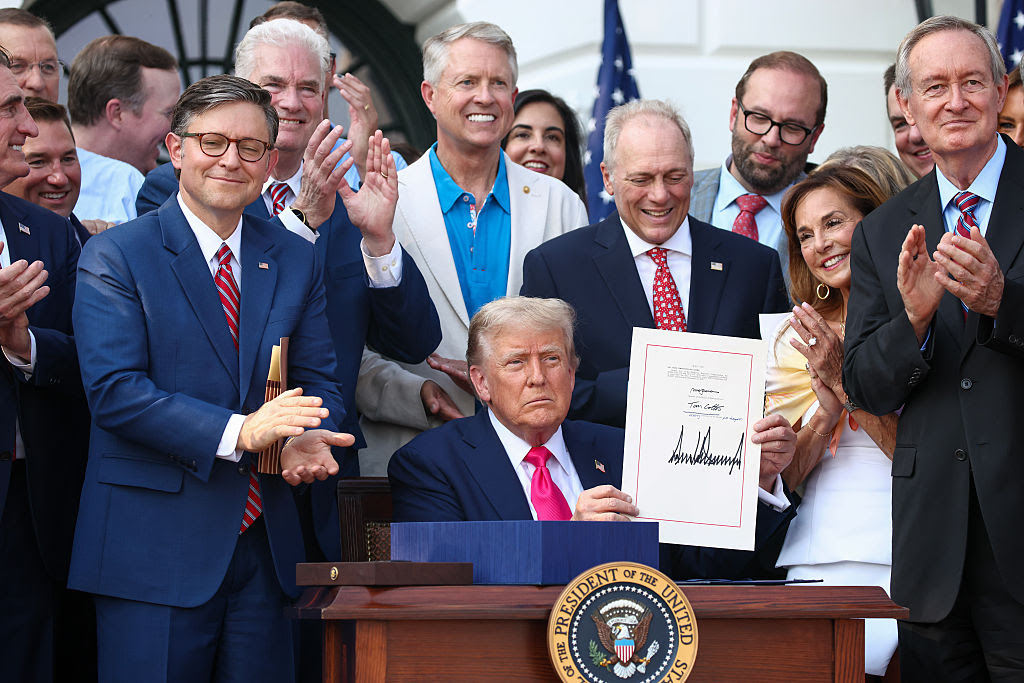Thom Hartmann has warned us again and again about Trump’s fascist plans. Now they are turning into action, and there’s no denying that every part of our democracy is being transformed into a tool of Trump’s ambitions for dictatorial power. Every government department is now led by a Trump sycophant. In his first term, Trump appointed some reputable people to burnish his credibility. In his second term, however, he has appointed people who have minimal experience or credibility. The chief qualification of his appointees is personal loyalty to Trump, not competence. E.G., Robert F. Kennedy Jr. was named Secretary of Health and Human Services, despite the fact that his hostility to vaccines and science are well known. Pete Hegseth, FOX News host, was made Secretary of Defense despite his absence of managerial experience. Kristi Noem’s main qualification was her obsequious devotion to Trump. This group will never consider invoking the 25th Amendment to remove Trump.
Thom Hartmann writes;
There’s no sugarcoating the truth: As fascism‘s grip tightens under Trump and the GOP, America’s government no longer operates as a constitutional republic.
Every federal institution now performs in synchronous mimicry of Dear Orange Leader’s unraveling psyche: false justifications, lop-sided pretenses of accountability, cosplay theater designed more for emotional spectacle than legal legitimacy, accelerating escalation at every turn.
The ostensible oaths to “support and defend the Constitution” are hollow, a ghost script read aloud while the regime marches America toward authoritarian collapse in the mode of Russia and Hungary.
Nothing — literally nothing organized or passed by Republicans in the last 44 years — was built to uplift average Americans. It’s all been engineered for power consolidation, GOP single-party rule, the wealth of the morbidly rich, and narrative control.
Consider the Justice Department. Once the nation’s arbiter of lawful conduct, it’s now Trump’s personal legal hit squad. Pam Bondi, who claimed she would end “weaponization” of the DOJ, created the novel “special prosecutor” role and appointed Ed Martin — an extremist QAnon promoter and January 6th fan — to target political enemies like Letitia James and Adam Schiff under what appear to be bogus pretexts.
The resulting spectacle, the parade of propaganda on rightwing TV and the circumvention of norms are all unconstitutional fascist grandstanding.
Meanwhile, in Washington D.C., a carjacking narrative involving two Black minors and a neo‑Nazi hacker nicknamed “Big Balls,” boosted by Elon Musk and Fox, has been seized upon to manufacture a crime panic.
It’s strikingly defiant of DOJ data, which confirms a 30‑year low in violent crime in the capital city. Trump harnessed the stunt to justify mobilizing ICE, the FBI, and the National Guard, weaponizing fear and fabrications to execute a federal coup on the city’s civil fabric.
This isn’t safety, it’s occupation.
At the FBI, Kash Patel is purging anyone not MAGA‑approved: long‑serving agents loyal to the institution, or even just connected to cases that charged Trump or January 6th insurrectionists, are being run out.
Patel’s attack on federalism reached a chilling new level when the FBI agreed to hunt down Texas Democratic state lawmakers who had fled to prevent mid‑cycle gerrymandering. No federal crime was under investigation, just a brazen attempt to subvert state sovereignty and tilt an election.
This is not law enforcement; it’s authoritarians seizing our nation’s legal infrastructure.
And then the propaganda arm roars in lockstep. Jesse Watters didn’t even bother to murmur coded dog whistles. He publicly declared the GOP must “kick illegal aliens out of the census,” gerrymander “to the hilt,” and lock Democrats into a “permanent minority.”
It’s open advocacy for one‑party rule rooted in gaslighting and cultural hatred. There are no quiet parts anymore: every word is a confession.
Public health and science have also been hijacked. Bob Kennedy oversaw the cancellation of 22 federal mRNA vaccine projects — including promising research into cancer and bird flu — with half a billion dollars cut. mRNA vaccines have already saved millions: Stopping that research amid emergent threats isn’t policy, it’s mass eugenics masquerading as public health.
Within the military, Pete Hegseth, a Trump loyalist, is rewriting history and norms: he wants Confederate base names restored, monuments to the traitors resurrected, public prayer institutionalized, and the values of supremacist preacher Doug Wilson — who believes women don’t deserve the vote and empathy is Satanic — amplified throughout the military.
That this is being done under the flag of “service” is a grotesque betrayal of the constitutional order.
ICE is being transformed into Trump’s personal masked, unaccountable, violent paramilitary. Official tweets now celebrate postings that solicit thugs — no degree required, no age limit — and glorify sadistic enforcement. This isn’t border control; it’s paramilitary recruitment for a fascist secret police force.
And now come the arrests.
Yes, the political arrests have already begun. In Newark, Mayor Ras Baraka attempted to participate in a congressional oversight visit to Delaney Hall, an ICE concentration camp. Federal agents arrested him. Charges were later dropped, and he is now suing for malicious prosecution and defamation, but the precedent was established.
At the same event, Congresswoman LaMonica McIver was indicted on three counts of assaulting, impeding, and interfering with federal officers, charges that carry up to 17 years. Her crime? Trying to protect the mayor and uphold legislative oversight. Multiple lawmakers and faith leaders have condemned the prosecution as politically motivated intimidation.
At the same time, Senator Alex Padilla was forcibly detained — assaulted, handcuffed, and violently dragged out — after attempting to question DHS Secretary Kristi Noem. He identified himself as a sitting senator; no charges were filed. Still, the message was clear: dissent has been criminalized and there will be a next time.
Add to that the targeting of a Wisconsin judge, Hannah Dugan. The FBI arrested and indicted her after she tried to help an undocumented immigrant evade arrest. She’s been suspended by the state Supreme Court. This is a judge facing prison for expressing compassion.
And let’s not forget the investigations aimed at AG Letitia James and Senator Adam Schiff. Trump’s federal authorities are now targeting elected officials over their political stances, without a shred of legal basis. These investigations are not about justice: they’re about vengeance, performative brutality, and raw power.
When institutional coercion becomes the norm, when political arrests replace constitutional rule, the democratic state has collapsed. Authoritarian regimes don’t wait until they hold 100% of power; they erode the system until the system can no longer resist them and democracy collapses. That’s exactly what we’re witnessing.
History echoes in every violation.
Remember Hitler writing Mein Kampf in prison, outlining Lebensraum, cloaking aggression as defense and reunification, always positioning himself as the reluctant warrior. He broke treaties, grabbed territory the way Trump is now threatening Greenland and Central America, and used the language of “peace” — always claiming that was his only goal — to mask aggression.
Churchill warned early in the 1930s, but was dismissed as a warmonger. Chamberlain chose to believe he could negotiate with a tyrant, and, as Churchill predicted, war followed.
Trump’s playbook is nearly identical: aggressive power grabs framed as patriotism, defenses against imaginary threats, mythmaking that declares “they made me do it.” And like in the 1930s, the enablers are eating it up.
But here’s the crucial difference: this fight isn’t a continent away; it’s in our towns, our courts, and our statehouses.
The Greatest Generation fought fascism overseas. Now we must fight it at home, in the institutions built on their sacrifice.
For that, we must act.
We can’t expect Congress to help: they’re under the control of Republicans completely subservient to their billionaire overlords.
We can’t expect the media to save us: they folded under Trump‘s threats and even handed him tens of millions of dollars for his personal use. CBS has even installed a “bias monitor” to make sure they don’t offend Trump or his people.
We can’t expect our corporate overlords to rescue our republic: they’ve already sold out for tax breaks, subsidies, and an end to limitations on their monopoly power.
We must become this century’s Greatest Generation: no passive hope, no waiting for saviors. Organize, protest, support independent journalism, call your representatives incessantly, primary the handful of craven “problem solver” Democrats, and support those who are willing to fight.
In Blue states, support those governors and legislators who are willing to gerrymander and otherwise use partisan power, including voter purges in Republican areas, when that’s what it takes to rescue our country.
The Republicans never waited for fairness: Democrats have to fight fire with fire.
When they go low, we mustn’t go high: we must fight ferociously, methodically, and effectively. Like the soldiers who landed on Normandy Beach and burned swastikas, we must disrupt, dismantle, and hold accountable every authoritarian ambition.
Trump is in collapse, his psyche fracturing, his infrastructure mirroring his breakdown, his institutions weaponized around his rage.
The rupture is real, and it’s here, now. There will be no more subtle signals. It’s confrontation or collapse.
Do not go gentle into that good night. Rage, rage against the dying of the light they are trying to force upon us.




















